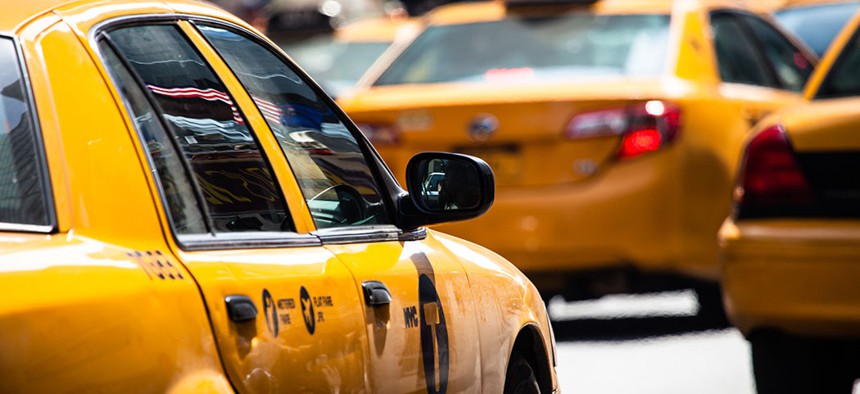When New York City’s first app-hailed ride took place in May 2011 in Manhattan, the U.S economy and New York were recovering from the Great Recession. Venture capital was beginning to pour into the on-demand digital economy. A San Francisco startup had effortlessly raised a funding round for an app-based service to let any person with a car and smartphone be a chauffeur. Its expansion was now focused on the megamarket of New York City, where their rollout would feature the iconic “I Love New York” brandmark adapted with an Uber logo.
New York’s taxi industry was just nearing its high-water mark with daily passenger pick-ups at an all-time record. A medallion later that year would be sold for the first time for $1 million. Medallion values increased nearly 2,000% in the three decades ending in 2014. Hailing a cab hadn’t changed in a century – an arm raised or two-fingered whistle still drew yellow cabs to the curb.
This passiveness to changing market conditions and technology is one of the reasons the taxi industry and local government now face off against the impregnable competition of tech behemoths. Even under the tech and business-minded mayoralty of Mike Bloomberg administration, New York City found itself playing catch-up to the tech upstarts – Uber, Lyft, Via – allowing outside players to upend the rules of the road for a once tightly-regulated industry.
And although the bubble that affected medallion prices popped and saw their market value drop by 80%, in part a result of brokers and private lenders operating with faint regulations when it came to lending practices, the Uber effect can’t be understated. It has weighed in heavily on yellow cab drivers and medallion owners and halved the number of traditional taxi pick-ups in the city. Ride hailing apps have had the same impact on U.S cities from San Francisco to Philadelphia.
Yet, New York City’s chance to compete with startups is far from over: The city’s Taxi and Limousine Commission should be looking to build or support better infrastructure for app-based dispatches and pick-ups. To do that, it should learn from its past failures.
Consider when, in 2013, the much anticipated startup, Hailo, entered the market to pilot e-hailing for yellow cabs, the TLC was slow to approve the service – Uber was the only greenlighted taxi app. Shortly after, Hailo’s entry into the market, supported by tens of millions in venture capital funding, turned to a retreat, as the London-based company cited “astronomical” marketing costs to match the strength of its competitors.
The second attempt at “appifying” yellow cabs came in 2015 when Arro, another privately held company released its app which combined two payment systems approved by the TLC. The app was plagued with problems from the start with a glitchy and inconsistent experience. One reporter at the time documented attempting to hail a yellow cab several times with great frustration. The following year, UberT experimented with yellow cab e-hails, which failed as result of surcharges and the requirement for cash payments.
Fast-forward to today and the competitive landscape has only worsened. Arro is still one of the apps, along with Curb, that enable yellow cab e-hails, but both fall short in functionality, usability and use.
Government shouldn’t play the role of kingmaker, where it picks market winners and casts competitors aside. The TLC, after all, operates as a regulatory agency intended to administer and oversee medallions as well as the vehicles and their drivers. It is not a fleet owner managing the business of operating cabs or providing personal transportation as a service.
However, the future of transportation will encompass more than micro-mobility, bicycles, and buses. It will continue to include personal and group transport – and one day, self-driving vehicles that will make human-driven vehicles cost-prohibitive.
If New York City doesn’t want it’s hallmark yellow cab to slowly disappear over the next decade, it will need to step in to refocus the TLC on a digital strategy and develop a roadmap for shielding the yellow cab industry from app attrition. Saving the industry, as some advocates argue, first requires rescuing underwater medallion owners. But a bailout would likely amount to one Band-Aid for an industry with many wounds.
A smarter, long-term strategy would be to invest in the already-existing infrastructure and the 13,500 brightly-colored yellow cabs on the road in order to increase ridership and continuously develop e-dispatch and digital solutions to stay ahead of the competition. Why shouldn’t a visitor share a yellow cab and split the costs with a stranger from JFK to Manhattan? Why can’t there be price estimate as soon as you take a backseat without the need for opening an app? Why not encourage loyalty and offer promotions for riding in a New York City taxi?
At the very least, as Mayor Bill de Blasio attempts to find a replacement head for the TLC, he can make a strategic hire that can allow New York City’s taxis to compete on the same level as Uber and Lyft: The next TLC commissioner should be a technologist – an entrepreneurial executive who can capitalize on the advantages that the yellow cab industry has and help it regain its footing. Increasing ridership through better ride experiences along with competitive costs is the only way for yellow cabs to survive. Barring the ability to build a TLC-based app service adopted by all medallion and fleet owners, at the very least this will need to be accomplished through much deeper partnerships with private e-hailing companies.
Short of this, we can expect yellow cabs to go the way of horse-driven carriage. New York City’s iconic yellow cab may become an experience for the sole enjoyment of tourists taking photos from the backseat of a cab.


